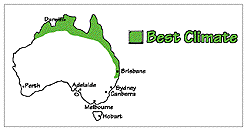Narrow Space Garden
The narrow area at the side of a house can often cause a problem for home owners and can become a neglected part of the garden. Don recently visited a narrow, neglected garden that has been transformed into an oasis of colour and foliage, thanks to garden designer Phillip O’Malley.
The small block size of this New Farm house in Brisbane has meant that the side garden was really the main garden area. It measures just 4 metres wide by 13.5 metres long (10×40′) and was narrower in some areas. Despite the narrow space, careful design and plant choice has resulted in a serpentine walk through a lushly planted area which feels and looks much larger than it really is.
Site problems and solutions
Most side gardens are long and narrow, which creates problems with the depth of garden beds, plant selection and choice of paving materials.
Phillip’s solutions:
Create a curving garden path. This gives the impression of a wider and longer garden by breaking with the linear effect. The gravel adds another dimension to this garden which has smooth decorative pedestals, fringed foliage and textured bark.
Phillip O’Malley has given height and structure to this garden by creating different planting levels. Mondo grass and bromeliads work well for groundcover plantings below the middle level of wine-coloured cordylines (Cordyline terminalis Hybrid). Towering over these are the Carpentaria palms (Carpentaria acuminata) which give height in this narrow space. Elsewhere syzygiums (Syzygium luehmannii), have been used to create a hedge underplanted with lower growing impatiens and the bold leaved acanthus (Acanthus mollis).
As well, pedestals, are used as a vertical, decorative feature uniting the garden.
As one wall of the garden is the wall of the house the paint colour chosen is an important part of the overall effect of the garden. Here a strong teal blue was used.
Suit your climate
These plantings are very suitable for this sub-tropical climate and have grown well in the short time they’ve been planted. By choosing plants that suit your climate you can have your garden looking good sooner. As well, using plants that suit the area allow your garden to reflect the wider environment. In Brisbane for example, the use of subtropical plants in gardens and street plantings heightens the feeling of living in a subtropical climate. In the past gardeners in warmer climates have often tried to grow and create gardens that echo those from cool climates, usually without much success.
Other plant choices
For gardeners in other climates a similar look to this tropical garden can be created using different plant choices more suitable for your area. The Carpentaria palms used in this garden are really only suitable for tropical and subtropical climates. In temperate or cooler areas you could substitute bangalow palms (Archontophoenix cunninghamiana) or kentia palms (Howea forsteriana) even in areas as far south as Melbourne.
Availability
The plants used in this garden would be available at garden centres. River pebbles used to create the serpentine path are available from landscape suppliers.
Further information
Phillip O’Malley is based on the Gold Coast but designs gardens from Brisbane to Melbourne. Phone: (07) 5485 2858. Web: http://phillipomalleygardendesign.com.au



